Random
Shots
- Armored Training -
Armored Training | Eboli
to Rome | To the Arno
| Northern ApenninesPo Valley | Vicenza Combat | Post-War | At Ease
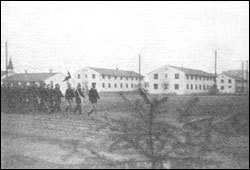 |
752nd troops march past the barracks at Ft. Lewis, Washington in the spring of 1942. Most of the initial cadre came from the Pacific Northwest states. Men eventually joined from all 48 states, D.C., and even two from Canada. However, analysis of a wartime roster indicates that the Mountain and Pacific states contributed twice as heavily to the 752nd as they did to the 1940 U.S. Census. The South was noticeably under-represented, but still contributed 24% of the battalion's strength. |
 |
Two tanker recruits of the 752nd train on the water-cooled M1917A .30 caliber machine gun at Fort Lewis in late 1941. The tankers became proficient on small arms weapons such as the rifle, carbine, grenades, and both the .30 and .50 caliber machine gun. Note the sharp slant of the tankers' hats over the left eye, which was characteristic of armored troops. |
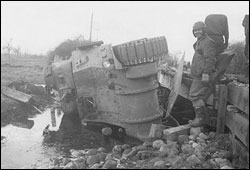 |
An overturned M3 of the 752nd at Fort Lewis. Things didn't always seem to go so well for man or machine during armored training. "Sarge, they just don't build bridges like they used to..." |
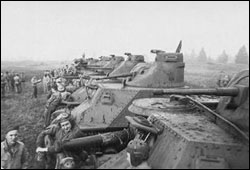 |
A line of 752nd M3's at Fort Lewis. The M3's high profile and the lack of traversible main gun proved to be serious combat liabilities. The first M3s to land in North Africa belonged to the 2nd Battalion of the 13th Armored Regiment. This unit was commanded by Lt. Col. Hyman Bruss, who later commanded the 752nd Tank Battalion. |
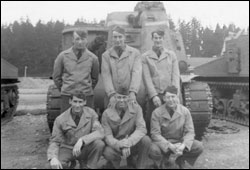 |
Crew of the "Donald Duck," an M3 tank of the pre-war 752nd. The M3s had a six man crew, consisting of a tank commander, 37mm gunner, 37mm loader, 75mm gunner, driver, and radio operator. Crew size was reduced to five men when the M4 Shermans were introduced. Private Ray Holt is front and center. |
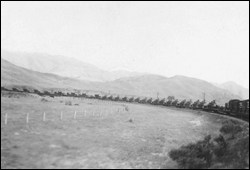 |
A troop train carrying Company B of the 752nd winds around a curve on its way from Ft. Lewis to the Desert Training Center in Indio, CA in mid-April 1942. Seventeen M3 tanks and several 2 ton trucks are loaded on flatbed cars comprising this section of the train. |
 |
Camp Young Desert Training Center at Indio, California. The 752nd trained here from April through July 1942 in preparation for combat in North Africa. The 752nd was trained under the direct supervision of General George S. Patton, who was always on the prowl. |
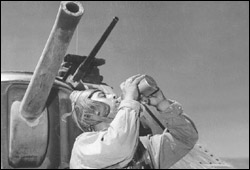 |
Corporal Phillip Margherito of the 752nd HQ Company takes a drink from his canteen at the Indio Desert Training Center 10 June 1942. Temperatures inside the tanks could reach 130 degrees in the desert. Corporal Margherito continued on with the 752 in Italy. (Official U.S. Signal Corps photo). |
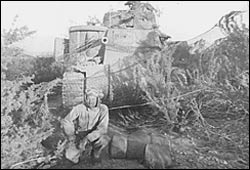 |
Private Raymond Holt poses in front of his camouflaged M3 "General Lee" tank at the Desert Training Center, Indio, California, May 1942. Note the extremely limited traverse of the 75mm gun -- a major liability of the M3. |
 |
The first overseas assignment for the 752nd was in England, where the unit remained from August 1942 to January 1943. The battalion is shown here in review at the Tidworth Barracks facility, located approximately 80 miles southwest of London. |
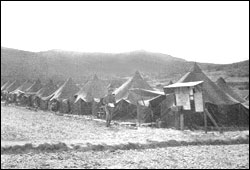 |
752nd battalion area in Tunisia. Due to a misinterpretation of War Department policy, the 752nd was inactivated and reclassified as the 2642nd Armored Replacement Battalion, which ran an Armored Training School in North Africa. After six months, the unit was reclassified as the 752nd Tank Battalion, but by that time combat in North Africa had already ended. |
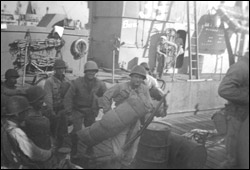 |
Men of the 752nd boarding LCIs (Landing Craft Infantry) at Bizerte Harbor on 10 January 1944, enroute from North Africa to Italy. At least 5 LCIs are known to have transported the battalion -- LCIs 37, 39, 47, 189, and 190. The uneventful journey lasted 2 days in beautiful weather, ending at Bagnoli (near Naples). The tanks were shipped on LSTs two days later. Although not legible in this small web photo, the Navy painted the initials "BIOYA" ("Blow It Our Your A..") on the side of the LST as a "welcome aboard" to the tankers. |
Researched and Written by Robert
J. Holt
Page Content Copyright 2003 - 2025 Robert J. Holt
All Rights Reserved